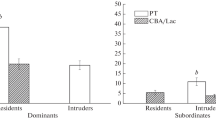Abstract
The level of aggressiveness and the weight of preputial gland and testis in male mice (Mus musculus) were influenced by housing condition, especially by the presence of cohabitant males. In this study, the relation between aggressiveness and the preputial gland and testis weight was studied for various housing conditions. The mouse individually housed in a cage that was linked to another cage containing another male separated by wire net was more aggressive than isolated or paired mice. The preputial gland weight also showed the same tendency, suggesting that the odor from other males promotes pituitary-gonadal activity in males, and that long-term cohabitance inhibits it.
Similar content being viewed by others
References
Alberts, J.R. & B.G. Galef 1971 Acute anosmia in the rat: a behavioral test of peripherally induced olfactory deficit.Physiol. Behav. 6: 619–621.
Brain, P.F. & N.W. Nowell 1970 The effects of differential grouping on endocrine function of mature male albino mice.Physiol. Behav. 5: 907–910.
Brain, P.F. & J.F. Goldsmith 1982 Involvement of various senses in responses to individual housing in laboratory albino mice 1. The olfactory sense.Boll. Zool. 49: 213–222.
Brain, P.F., M.H. Homady & M. Mainardi 1983 Preputial glands, dominance and aggressiveness, in mice.Boll. Zool. 50: 173–187.
Bronson, F.H. & B.E. Eletheriou 1965 Relative effects of fighting on bound and unbound corticosterone in mice.Proc. Soc. exp. Bid. Med. 118: 146–149.
Bronson, F.H. & C. Desjardins 1971 Steroid hormones and aggressive behavior in mammals. In: B. E. Eleftheriou & J. P. Scott (eds.)Physiology of Aggression and Defeat pp. 43–63 Plenum Press, New York.
Bronson, F.H. & H.M. Marsden 1973 The preputial gland as an indicator of social dominance in male mice.Behav. Biol. 9: 625–628.
Cairns, R.B. & S.D. Scholz 1973 Fighting in mice: dyadic escalation and what is learned.J. Comp. Physiol. Psychol. 85(3): 540–550.
Edwards, D.A. 1974 Non-sensory involvement of the olfactory bulbs in the mediation of social behavior.Behav. Biol. 11: 287–302.
Goldsmith, J.F. & P.F. Brain 1978 Effect of prior housing conditions on adrenocortical and gonadal responses to differential housing in laboratory mice.J. Endocrinol. 77: 56–57.
Goldsmith, J.F., P.F. Brain & D. Benton 1976 Effects of age at differential housing and the duration of individual housing/grouping on intermale fighting behavior and adrenocortical activity in TO strain mice.Aggressive Behav. 2: 307–323.
Hammour, H., J.F. Goldsmith & P. F. Brain 1982 Effects of sensory communication on development of “isolation induced” aggression in laboratory mice.Aggressive Behav. 8: 133–136.
Hayashi, S. 1986 Effects of a cohabitant on preputial gland weight of male mice.Physiol. Behav. 38: 299–300.
Hayashi, S. 1987 The effects of preputialectomy on aggression in male mice.Zool. Sci. 4: 551–555.
Hayashi, S. 1988 Male mice: social dominance influenced by strange male odors.Aggressive Behav. 15: 1–3.
Hayashi, S. 1993 Development and diversity of social structure in male mice.J. Ethol. 11: 77–82.
Koyama, S. 1993 Isolation effect in mice (Mus musculus): (1) does it really induce aggression?J. Ethol. 11: 117–130.
Leshner, A.I. 1975 Theoretical review. A model of hormones and agonistic behavior.Physiol. & Behav. 15: 225–235.
Parmigiani, S., D. Mainardi & A. Pasquali 1981 A comparison of aggressiveness in dominant subordinate and isolated house mice. In: P. F. Brain & D. Benton (eds.)The biology of aggression, pp. 563–570 Sythoff & Noordhoff International Publishers, Netherlands.
Parmigiani, S. & P.F. Brain 1983 Effects of residence, aggressive experience and intruder familiarity on attack shown by male mice.Behav. Processes 8: 45–57.
Scott, J.P. & E. Fredericson 1951 The causes of fighting in mice and rats.J. Physiol. Zool. 24: 273–309.
Sigg, E.B., C. Day & C. Colombo 1966 Endocrine factors in isolation-induced aggressiveness in rodents.Endocrinology 78: 679–684.
Author information
Authors and Affiliations
About this article
Cite this article
Tanabe, M., Kimura, T. Aggression and preputial gland of male mice affected by the presence of other males. J. Ethol. 13, 63–68 (1995). https://doi.org/10.1007/BF02352564
Received:
Accepted:
Issue Date:
DOI: https://doi.org/10.1007/BF02352564




